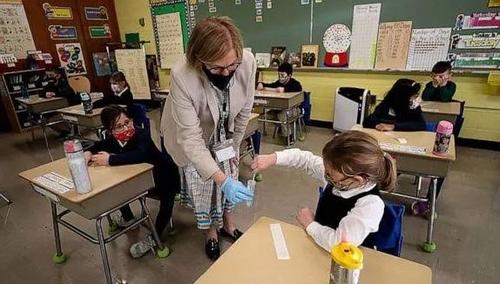by TYLER DURDEN
After telling the public that there’s no reason yet to believe they will need COVID “booster shots”, the CDC released more updated guidance on Friday morning. This time, the updated guidance focused on precautions that K-12 public schools should take during the upcoming 2021-2022 school year.
Most importantly, the guidance included a directive that schools should remain open regardless – even in the event of an outbreak – regardless of whether all COVID-prevention strategies can be implemented.
The new federal guidelines aren’t mandatory, but they’re supposed to give public school administrators a framework to help navigate the complexities of teaching during the COVID era.
The updated guidance, which can be read in full here, advised that in-person education is a “priority”. Importantly, schools will be asked to keep track of which students and staff have been “fully vaccinated”.
First, the most important thing schools can do is encourage as many students and staff to get vaccinated as possible.
“Achieving high levels of COVID-19 vaccination among eligible students as well as teachers, staff, and household members is one of the most critical strategies to help schools safely resume full operations,” the CDC stated.
Since not all students will be vaccinated by the conclusion of the upcoming school year, authorities should balance promoting vaccination with modified social distancing strategies. For example, all students should maintain at least 3 feet of physical distance inside classrooms. If this isn’t possible, then schools should resort to “layered” strategies including frequent testing, ventilation, handqashing and “respiratory etiquette”.
School administrators should keep track of levels of COVID prevalence within the surrounding community.
Students and teachers won’t be asked to wear masks outside, but when levels of transmission in the surrounding community are high, even the vaccinated may be asked to mask up indoors. Additionally, the CDC recommends that bus drivers and their passengers wear masks during the ride to and from school, regardless of whether they’re vaccinated or not.
For staff and students who aren’t vaccinated, the guidance recommends testing them at least once per week, or possibly more if transmission rates in the community rise. For students involved in sports, they may be asked to be tested twice per week.
Since the CDC has no real authority, it makes clear in the guidance that schools will be responsible for deciding which guidelines to follow.
Aside from delving into the ethical guidelines for encouraging vaccination, other “prevention strategies” include promoting vaccination, consistent and correct mask usage, physical distancing, screening testing to promptly identify cases, clusters and outbreaks, ventilation, handwashing and respiratory etiquette, staying home when sick and getting tested, contact tracing (in combination with isolation and quarantine), cleaning and idsinfection.
Schools can mix and match the tactics that work best for them. The need for layering specific prevention strategies will vary, and localities might implement fewer COVID-19 prevention strategies based on community transmission levels, vaccination coverage, and local policies and regulations.
Some schools might opt to embrace these guidelines to the letter, while others might reject them entirely. In Arizona, Chandler Unified School District, which welcomes back students July 21 (one of the earliest start dates in the US) has already decided that masks will be voluntary. In fact, Republican Gov. Doug Ducey signed a law that prohibits local counties and school districts from requiring students or staff to wear face coverings.







